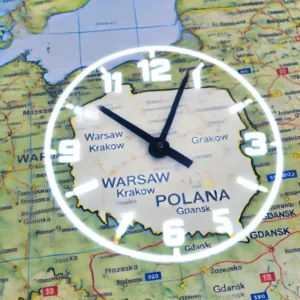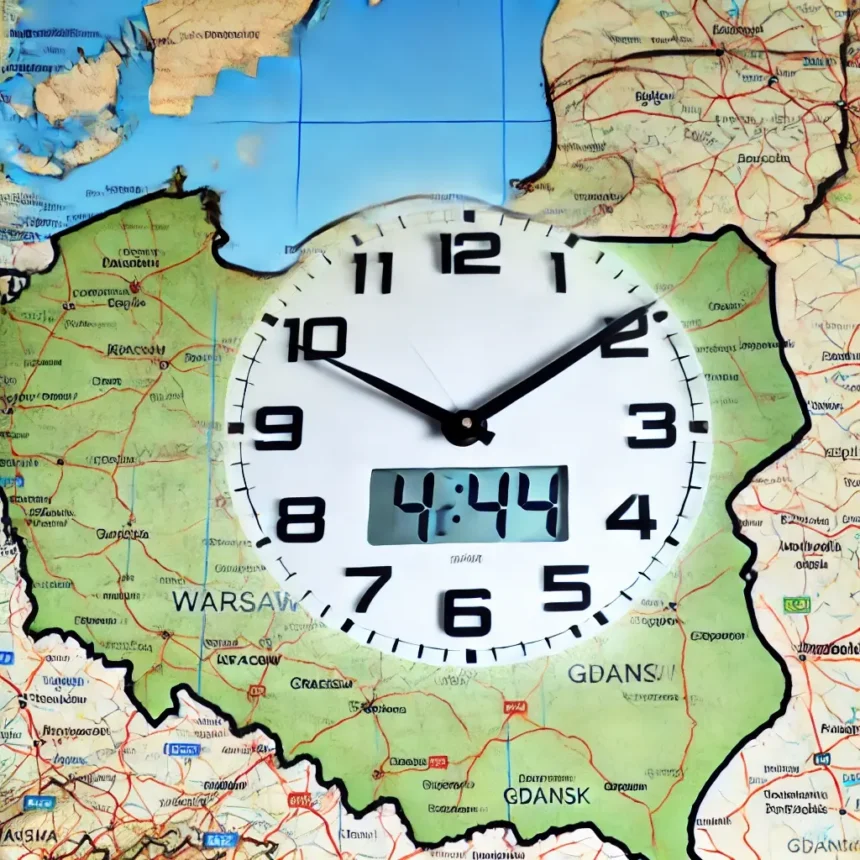Introduction: time in Poland
Poland in Poland is a beautiful country located time in poland Central Europe, known for its rich history, culture, and scenic landscapes. The country operates in the Central European Time Zone (CET), which is UTC+1. However, Poland also observes Daylight Saving Time (DST), shifting the clock one hour forward during the summer months, making it UTC+2 during this period.
Understanding the time in Polands is important for anyone traveling to the country, doing business, or communicating with people living there. The time in Polands is aligned with several European countries, making it convenient for cross-border trade and travel. Knowing the local time helps avoid confusion, especially when coordinating schedules across different time zones.
What Time Zone Is Poland In?
Poland operates under Central European Time (CET), which is UTC+1. This time zone is widely used in Europe, including countries like Germany, Italy, and France. It helps create uniformity across the continent, simplifying travel and communication within the region.
When Daylight Saving Time (DST) is in effect, the country shifts to Central European Summer Time (CEST), which is UTC+2. DST usually starts at the end of March and ends at the end of October. This shift is made to make better use of daylight during the longer summer days.
Current Time in Poland
The current time in Polands depends on whether the country is observing standard time or DST. During the winter months, the country follows CET (UTC+1), and during the summer months, it observes CEST (UTC+2).
For example, if you are in the United States on the East Coast (Eastern Standard Time, EST), there is usually a six-hour difference between Poland and the US during standard time and a five-hour difference when Poland is observing DST.
Why Does Poland Observe Daylight Saving Time?
Poland, like many other European countries, observes Daylight Saving Time to make better use of natural daylight during the summer. By shifting clocks one hour forward, the country enjoys longer daylight in the evening, helping people save on energy and make the most out of their outdoor activities.
DST begins on the last Sunday of March and ends on the last Sunday of October. During this time, clocks are moved one hour ahead to transition from CET (UTC+1) to CEST (UTC+2).
Benefits of Knowing the Time in Poland
1. Travel Planning
Knowing the time in Polands is essential for travelers, especially those coming from different time zones. Adjusting to the local time zone helps minimize jet lag and ensures travelers are on schedule for flights, trains, and other modes of transportation.
2. Business Communication
Poland has a thriving business environment, and many international companies collaborate with Polish businesses. Understanding the time zone in Poland is crucial when scheduling meetings or sending time-sensitive emails to Polish partners.
3. Keeping in Touch with Loved Ones
With many people having family and friends living abroad, knowing the time in Polands helps maintain smooth communication. It prevents awkward situations, like calling too early in the morning or too late at night, which could disturb someone’s sleep.
Major Cities and Time in Poland
1. Warsaw
The capital city of Poland, Warsaw, operates in the Central European Time Zone (CET) during the winter and the Central European Summer Time Zone (CEST) during the summer. Like the rest of Poland, Warsaw follows the standard practice of adjusting the clocks for DST.
2. Krakow
Krakow is another major city in Poland known for its rich history and culture. The time in Krakow follows the same time zone rules as Warsaw. Whether you’re visiting for tourism or business, you will experience the same time as the capital.
3. Gdansk
Gdansk, a significant port city on the Baltic coast, also follows CET and CEST during the respective seasons. This coastal city is a popular tourist destination, and understanding the time zone helps visitors plan their activities.
Daylight Saving Time Transitions
1. Start of Daylight Saving Time
In Poland, DST starts on the last Sunday in March. At 2:00 AM CET, the clock is moved one hour forward to 3:00 AM CEST. This time shift means one less hour of sleep, but it extends daylight in the evenings.
2. End of Daylight Saving Time
DST ends on the last Sunday of October. At 3:00 AM CEST, the clock is moved one hour back to 2:00 AM CET. This shift gives people an extra hour of sleep, but it also means that the days become shorter, with sunset occurring earlier.
Time Differences Between Poland and Other Countries
1. Poland and the United States
The time difference between Poland and the United States varies depending on the time zone and whether DST is being observed. For example, Poland is generally six hours ahead of Eastern Standard Time (EST) during standard time and five hours ahead when Poland is observing DST.
2. Poland and the United Kingdom
During standard time, Poland is one hour ahead of the United Kingdom. However, when both countries observe DST, the time difference remains the same, with Poland still one hour ahead.
3. Poland and Australia
The time difference between Poland and Australia is significant due to the geographic distance. Depending on the region of Australia, the time difference can range from eight to eleven hours, making it crucial to plan communication or travel carefully.
How to Check the Time in Poland
With the advancement of technology, checking the time in Polands is easier than ever. You can use:
1. Online World Clocks
There are various websites and apps that allow you to check the current time in Polands. These tools provide real-time updates and are helpful for those coordinating international meetings or events.
2. Mobile Apps
Many smartphones come with world clock features, allowing you to add Poland’s time zone to your list and easily check it whenever needed. These apps often adjust automatically during Daylight Saving Time transitions, ensuring accuracy.
3. Smart Devices
Smart home devices like Google Home and Amazon Alexa can also provide the current time in Polands upon request. Simply ask your smart device what the time is in Poland, and it will give you an accurate response.
Time-Related Cultural Aspects in Poland
1. Punctuality
Punctuality is highly valued in Poland, especially in business settings. People are expected to arrive on time for meetings, appointments, and social gatherings. Being late is often seen as disrespectful, so understanding and respecting the local time is essential.
2. Public Transport
Poland’s public transport system, including trains and buses, runs on strict schedules. Travelers should always be aware of the local time to ensure they do not miss their departure.
How to Adjust to Poland’s Time Zone
1. For Travelers
To adjust to Poland’s time zone, it’s best to start adapting a few days before your trip. Gradually shift your sleeping and eating schedule to align with Poland’s time. Once you arrive, spend time outdoors in natural sunlight, which can help your body adapt faster.
2. For Remote Workers
If you work remotely and need to align with Poland’s time zone, create a schedule that overlaps with your Polish colleagues’ work hours. Use tools like Google Calendar to set reminders for meetings in the correct time zone.

Frequently Asked Questions (FAQs)
1. What is the current time in Polands?
The current time in Polands depends on whether the country is observing CET or CEST. During the winter, Poland follows CET (UTC+1), and during the summer, it follows CEST (UTC+2).
2. When does Poland switch to Daylight Saving Time?
Poland switches to Daylight Saving Time on the last Sunday of March, moving the clock one hour forward.
3. How do I adjust to Poland’s time zone?
To adjust to Poland’s time zone, gradually shift your sleep schedule before traveling and spend time in natural daylight upon arrival.
4. What is the time difference between Poland and the US?
Poland is generally six hours ahead of the US Eastern Time Zone (EST) during standard time and five hours ahead during Daylight Saving Time.
5. Does Polands observe Daylight Saving Time?
Yes, Polands observes Daylight Saving Time from the last Sunday in March to the last Sunday in October.
Conclusion
Understanding the time in Polands is essential for travelers, business professionals, and anyone communicating with people in the country. Whether it’s knowing the time zone, adjusting to Daylight Saving Time, or planning meetings, being aware of the local time ensures smoother communication and travel experiences.





